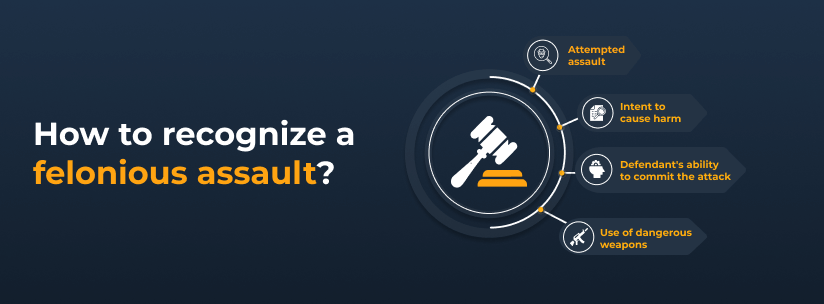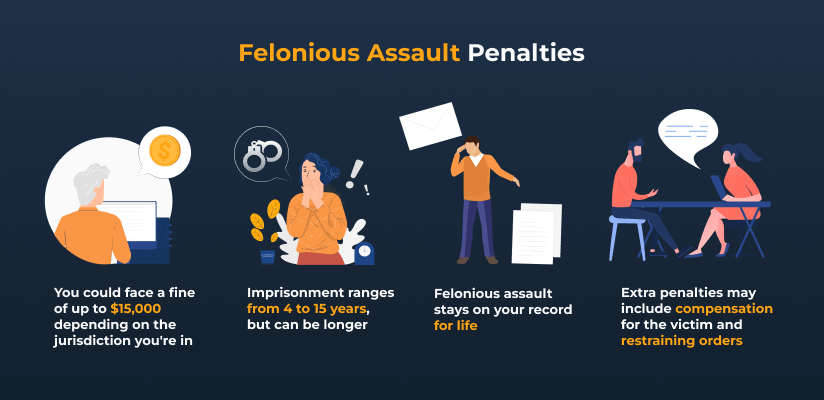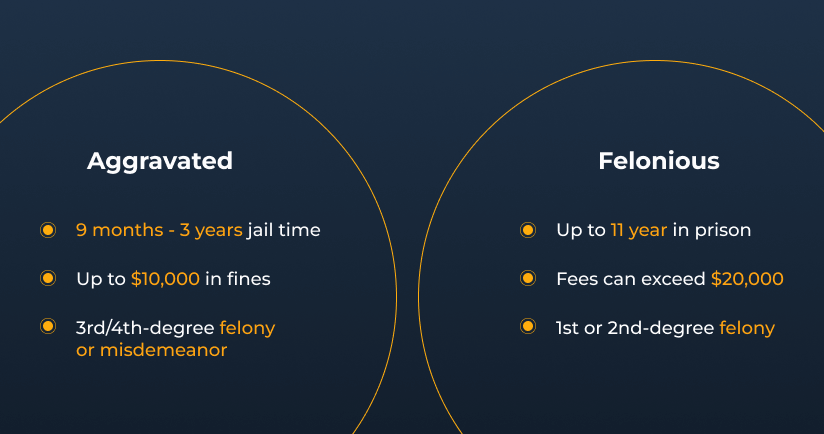
In 2022, over 370,347 assaults in the US involved dangerous weapons like handguns, knives, and firearms. The rate of aggravated violence reached 268.2 cases per 100,000 people. In this article, we will analyze which attacks qualify as felonious assaults from this large number. We will also explore the main elements of the concept and the legal penalties for this crime. So, let’s start!
First, let’s look at what attacks are serious crimes at all and define felonious assault.

In federal definition, assault is an attempt with force or violence to cause physical harm to another, or an act that puts someone in the apprehension of such harm.
The federal assault statute 18 U.S.C. § 351 divides these attacks into two categories. The first one, which results in personal injury, is punishable by up to 10 years of imprisonment. This is a felony assault.
The second category includes all other attacks that don’t result in personal injury, punishable by up to 1 year of imprisonment and a fine. Technically, this defines a misdemeanor assault.
So, signs of felony assault include
Misdemeanor assaults involve minor physical altercations without serious injury and the use of deadly weapons. They usually don’t intend to cause significant harm. So, not all assaults are felonies.
Felonious assault involves causing serious physical harm by using a deadly weapon in an attempt to cause this damage. It can also encompass forms of sexual assault and attacks on children and infants. Weapons in this case also can vary from firearms and knives to everyday objects like rocks or hammers.
The legal felonious assault definition varies from state to state. Here is a table with variations in the approach to this term in different states:
Ohio
Causing or attempting to cause serious physical harm to another or an unborn child; using a deadly weapon in an assault.
Includes serious physical harm and the use of deadly weapons. Focus on causing harm on intent.
Ohio Revised Code Section 2903.11
Michigan
Assault with a dangerous weapon with intending to commit murder or to inflict great bodily harm less than murder.
Emphasizes the use of dangerous weapons.
Michigan Penal Code
California
Assault with a deadly weapon other than a firearm, or by any means of force likely to produce great bodily injury.
Includes various types of weapons and focuses on the potential to cause serious injury. Differentiates between types of weapons used.
California Penal Code Section 245
New York
Assault with intent to cause physical injury with a weapon, causing serious physical injury, or assault on a police officer or while in prison.
Includes specific victim classes, emphasizes serious physical injury, and different types of weapons.
New York Penal Law Section 120.05
Texas
Causing serious bodily injury to another or using or exhibiting a deadly weapon during the commission of the assault.
Focus on serious bodily injury and deadly weapon use. Includes various aggravating circumstances.
Texas Penal Code Section 22.02
Florida
Aggravated assault with a deadly weapon without intent to kill or with intent to commit a felony.
Emphasis on the use of deadly weapons and intent behind the assault. Differentiates between intent to kill and to commit a felony.
Florida Statutes Section 784.021

Felonious assault in Ohio addresses cases where an individual with the AIDS virus engages in sexual conduct without informing their partner. The law also takes into account the victim’s mental capacity and age. It particularly focuses on victims under 18 who are not married to the offender. It is a 2nd-degree felony assault but can escalate to a 1st-degree if the victim is a police officer.
Michigan’s law encompasses felonious assault with a deadly weapon, such as guns, knives, and clubs. This applies even when there’s no intention to murder or inflict serious harm. Furthermore, the statute includes special provisions for assaults in weapon-free school zones. In these cases, penalties can be more severe, including community service or higher fines.
In New York, the law protects train operators, healthcare workers, and public service employees. The law shields them from assaults that occur while they are on duty.
In Texas, if the assault targets a public servant, is in retaliation against a witness, or involves firing a gun from a motor vehicle, the offense is more serious. These factors raise the level of the crime.
So, the elements of felonious assault include the following key components:
The combinations of these elements may depend on state law. For example, an assault with a deadly weapon or on a police officer will be a felony, even without an intent to harm. On the other hand, the element of the lack of consent of the victim is more relevant to cases of aggravated felonious sexual assault.
Keep reading to find out how much time a defendant gets for felonious assault and what fees to expect.

For a felonious assault, jail time can range from 4 years to up to 15 years. Fines vary up to $15,000. For aggravated felonious assault, the court can sentence even 20 years in prison to life imprisonment.
Ohio
Assault in the second degree
Up to 8 years
Up to $15,000
Michigan
Felony
Up to 4 years
Up to $2,000
California
Varies
Up to 4 years
Up to $10,000
New York
Class D felony
2 to 7 years
Up to $5,000
Texas
Second or first-degree felony
2 to 20 years (2nd degree); 5 to 99 years or life (1st degree)
Up to $10,000
Florida
3rd-degree felony
Up to 5 years
Up to $5,000
The court tailors these consequences to each case based on the offender’s history and the victims’ needs. They serve both punitive and rehabilitative purposes. Courts set these penalties and conditions based on local laws and sentencing guidelines.
A felony charge, such as felonious assault, stays on your record for life. The only way to remove it is through a process called expungement. But many states don’t expunge violent felonies. For instance, California permits setting aside most crimes after a waiting period (1-4 years on average).
Arizona’s law allows sealing misdemeanors and most felonies after waiting 2 to 10 years. Connecticut’s “Clean Slate” law erases certain crimes automatically. Expungement depends on waiting periods, proof of rehabilitation, and offense nature. Without this process, a felony remains on the record permanently.
Yes, it is possible to receive probation for felonious assault. Felony probation is an alternative to prison when a convicted person serves a sentence in the community under supervision. But only some qualify for it. A judge determines eligibility by these factors:
The probation process includes regular check-ins with an officer and restitution payment, drug tests, and counseling. It can last up to 5 years. But those with violent or serious felonies, offenses committed while already on probation, or certain sex crimes may not qualify.
Check out our article “What Field of Law Makes the Most Money in the USA?“

Although these two concepts may seem similar, they are distinct and carry different penalties under the laws of some states. Thus, felonious assault with specifications is a more serious crime than an aggravated one. The last one is sometimes even convicted as a misdemeanor. Let’s compare it using the example of Ohio and Michigan.
Definition
Michigan
Assault with a dangerous weapon (e.g., gun, knife, iron bar).
Based on the victim’s injuries.
Ohio
It is causing serious physical harm to another person or an unborn child. Includes the use of a deadly weapon or firearm.
A crime occurs when the offender, in a state of extreme emotional disturbance or sudden rage, inflicts serious harm.
Key Point
Michigan
Doesn’t need actual use of the weapon. A mere threat is enough.
Injury needs immediate medical treatment and causes disfigurement, impairment of health, or body parts.
Ohio
-
The victim must provoke this emotional state.
Degree
Michigan
Felony
Misdemeanor
Ohio
1st or 2nd-degree felony
3rd or 4th-degree felony
Penalties
Michigan
Up to 4 years in prison and a $2,000 fine
Up to 1 year in jail and a $1,000 fine
Ohio
Up to 11 years in prison, fine up to $20,000
9 months - 3 years in prison, fine up to $10,000
Felonious assault often involves serious bodily harm or the use of a deadly weapon. To claim self-defense, you must prove that your actions were a necessary response to an immediate threat. In this case, you need to hire or at least consult a criminal defense attorney. An experienced lawyer will guide you through the laws of your state and help you build a strong defense.
Aggravated and felonious assault are not the same. The last one involves serious physical harm and often includes the use of a deadly weapon or firearm. But in Ohio, for example, aggravated assault occurs when the offender, in a state of extreme emotional disturbance or sudden rage, inflicts serious harm. The legal penalties and degrees of the crimes also are more serious for felonious assault.
Felonious behavior involves committing serious crimes known as felonies. These crimes are more severe than misdemeanors and usually include acts like violent crimes or large-scale theft. This behavior breaks significant criminal laws.
To prove an assault, there are three key elements required:
An assault becomes a felony if it causes serious physical injury to the victim. It also turns into a felony when the assailant uses a deadly weapon or targets certain protected people, like police officers.
Felony assault involves serious physical harm to someone or using a deadly weapon during the assault. It can also include assaults against certain protected groups like police officers.










